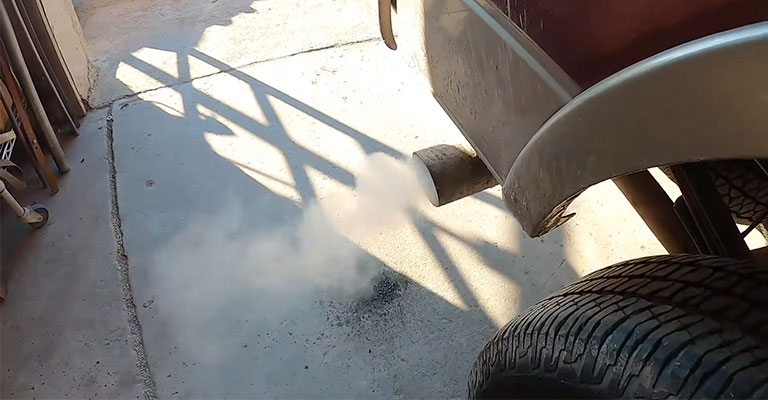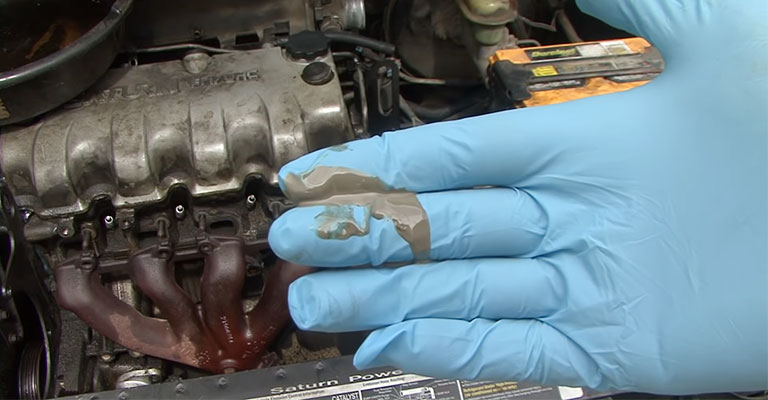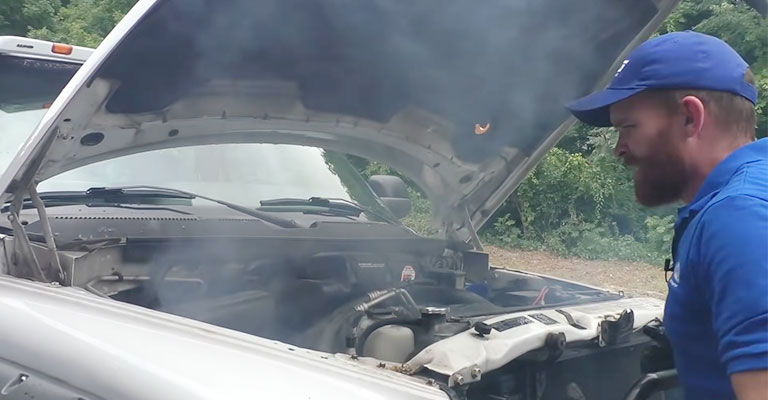A blown head gasket is a common problem on vehicles. It occurs when the seal between the engine block and head (the part of the engine that contains the valves) fails. This allows hot gases and oil to leak into the engine, causing it to overheat.
Some symptoms of a blown head gasket may include a loss of power and poor fuel economy. If you’re experiencing any of these issues, it may be time to have your head gasket replaced.
7 Signs of Blown Head Gasket
If you are seeing any of the following signs, it is important to have your car inspected and repaired as soon as possible:
white smoke coming from the tailpipe, bubbling in the radiator and coolant reservoir, coolant loss with no leaks, a milky white coloration in the oil, engine overheat. Here we are gonna explain them.
1. White Smoke Coming from the Tailpipe

If you notice white smoke coming from your car’s exhaust, it could be a sign of a blown head gasket. This issue is commonly caused by antifreeze leaking past the gasket and into the cylinders. The steam created during combustion will mix with the antifreeze and create clouds of white smoke.
If you notice an oil leak coming from one of your car’s cylinders, this could be the cause of the white smoke. To fix this problem, you’ll need to allow combustion pressure into the cooling system.
A blown head gasket can be a sign of a more serious issue, such as a broken radiator.
Checking the dipstick is essential to determining the cause of the blown head gasket.
If the radiator hose is suddenly blown off, it could be the cause of the white smoke. Taking the car in for service is the best course of action in this situation.
2. Bubbling in The Radiator and Coolant Reservoir
If you notice bubbling or a decrease in coolant levels in your radiator, it’s a sign of a blown head gasket. This can lead to overheating and even a breakdown in the engine.
When a head gasket blows, the air compressed by the cylinders can have too much force and enter the cooling system. This leads to bubbling in the reservior and an antifreeze leak that can cause the engine to overheat.
3. Milky white Coloration in the Oil

If you notice a milky white coloration in your oil, this is a sign of a blown head gasket.
Look for milky white coloration in the oil. The oil filler cap or the dipstick should be filled with milky sludge. Head gasket failure is the clearest sign of this issue.
4. Engine Overheating

Engine overheating is a clear sign that your head gasket may have blown. Once your engine overheats, it will cause the parts to swell. This will lead to the head gasket leaking, and eventually the engine will fail.
Keep an eye on your engine temperature and keep an inventory of all the parts that have swollen in case of a head gasket leak.
5. Idle Rough
If your car idles rough or has a problem starting, it is likely that your head gasket has blown. If your car has been sitting for an extended period of time, the head gasket will most likely have blown.
A blown head gasket can cause your car to idle rough and have a difficult time starting.
If you have a head gasket that has blown, your car may run poorly and have a lot of issues. If you are experiencing any of the above signs, it is important to take your car to a mechanic as soon as possible.
6. Oil Contamination

If you see milky sludge on the underside of the oil filler cap or the dipstick, this means oil contamination. This is a sign that the engine has been contaminated with antifreeze, and will need to be replaced.
If the engine has been contaminated with antifreeze, it will produce a milky sludge on the oil filler cap and dipstick. If you see this sign, it is important to take action and have the engine replaced.
Always be cautious when working with engine oil, and make sure to keep it clean to avoid oil contamination.
7. External Leaks
Look for external leaks, which is a sign of a blown gasket. If you see coolant or oil seeping out of the engine, it’s time to replace the gasket. If the gasket is blown, it will most likely cause a coolant or oil leak.
External leaks are the least cause of blown gasket but its serious too.
Some Other Thoughts
What does a car sound like with a blown head gasket?
When your car has a blown head gasket, you may hear an exhaust leak sound. The noise is usually loud and will vary depending on the make and model of your car.
When a head gasket blows, the compressed air and fuel can escape, leading to a reduction in engine power. The sound of a blown head gasket can be similar to that of an exhaust leak. The compression of the cylinder can cause a rough running engine.
How common is a blown head gasket?
Head gaskets blowing can be a common problem for older cars, and if not fixed, can lead to engine failure. If you have an old car, it is important to check your head gasket every mile.
Head gaskets typically last a lifetime, but if it fails prematurely it can cause a lot of problems. If you are experiencing any engine problems, it is important to get it fixed as soon as possible. Typically head gaskets last 200000 miles.
Conclusion
If you’re experiencing a lot of engine noise and your car seems to be losing power, then it may be time to have the head gasket replaced. A blown head gasket can result in major engine damage, so if you notice any of the following signs, it’s important to get your car checked out:
-Noise coming from under the hood
-Loss of power when driving

Leave a Reply